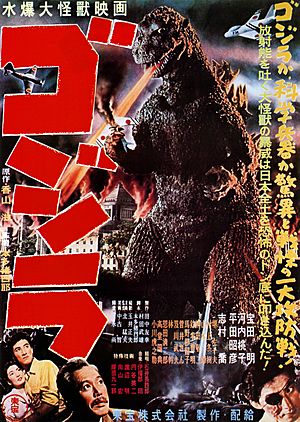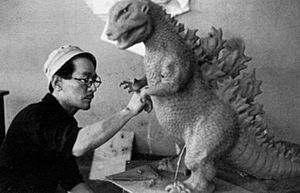Godzilla facts for kids
Godzilla is a giant dinosaur-like fictional monster who first appeared in movies from Japan, in the year 1954. Since then has been featured in twenty-nine movies. During his movie career, this large reptile fought against many other mythical monsters, including the giant moth-like Mothra, the three-headed King Ghidorah, his own robotic mirror image Mechagodzilla, and several more enemies. The original Japanese name, Gojira, is a combination of the words gorilla and kujira (means whale). In countries where the primary language is English, the name has been changed to Godzilla.
Contents
Characteristics
Within the context of the Japanese films, Godzilla's exact origins vary, but it is generally depicted as an enormous, violent, prehistoric sea monster awakened and empowered by nuclear radiation. Godzilla's character design was conceived as that of an amphibious reptilian monster based around the loose concept of a dinosaur with an erect standing posture, scaly skin, an anthropomorphic torso with muscular arms, lobed bony plates along its back and tail, and a furrowed brow.
Roar
Godzilla has a distinctive disyllabic roar (transcribed in several comics as Skreeeonk!), which was created by composer Akira Ifukube, who produced the sound by rubbing a pine tar-resin-coated glove along the string of a contrabass and then slowing down the playback. In the American version of Godzilla Raids Again (1955) titled Gigantis the Fire Monster (1959), Godzilla's roar was mostly substituted with that of the monster Anguirus. From The Return of Godzilla (1984) to Godzilla vs. King Ghidorah (1991), Godzilla was given a deeper and more threatening-sounding roar than in previous films, though this change was reverted from Godzilla vs. Mothra (1992) onward. For the 2014 American film, sound editors Ethan Van der Ryn and Erik Aadahl refused to disclose the source of the sounds used for their Godzilla's roar. Aadahl described the two syllables of the roar as representing two different emotional reactions, with the first expressing fury and the second conveying the character's soul.
Size
Godzilla's size is inconsistent, changing from film to film and even from scene to scene for the sake of artistic license. The miniature sets and costumes were typically built at a 1⁄25–1⁄50 scale and filmed at 240 frames per second to create the illusion of great size. In the original 1954 film, Godzilla was scaled to be 50 m (164 ft) tall. This was done so Godzilla could just peer over the largest buildings in Tokyo at the time. In the 1956 American version, Godzilla is estimated to be 121.9 m (400 ft) tall, because producer Joseph E. Levine felt that 50 m did not sound "powerful enough".
As the series progressed, Toho would rescale the character, eventually making Godzilla as tall as 100 m (328 ft). This was done so that it would not be dwarfed by the newer, bigger buildings in Tokyo's skyline, such as the 243-meter-tall (797 ft) Tokyo Metropolitan Government Building which Godzilla destroyed in the film Godzilla vs. King Ghidorah (1991). Supplementary information, such as character profiles, would also depict Godzilla as weighing between 20,000 and 60,000 metric tons (22,050 and 66,140 short tons).
Abilities
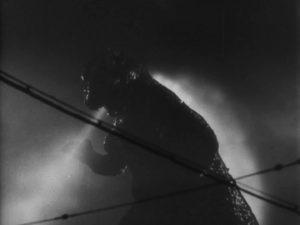
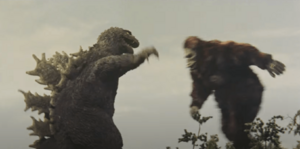
Godzilla's signature weapon is its "atomic heat beam" (also known as "atomic breath"), nuclear energy that it generates inside of its body, uses electromagnetic force to concentrate it into a laser-like hypersonic projectile and unleashes it from its jaws in the form of a blue or red radioactive beam. Toho's special effects department has used various techniques to render the beam, from physical gas-powered flames to hand-drawn or computer-generated fire. Godzilla is shown to possess immense physical strength and muscularity. Haruo Nakajima, the actor who played Godzilla in the original films, was a black belt in judo and used his expertise to choreograph the battle sequences.
Godzilla is amphibious: it can breathe underwater and is described in the original film by the character Dr. Yamane as a transitional form between a marine and a terrestrial reptile. Godzilla is shown to have great vitality: it is immune to conventional weaponry thanks to its rugged hide and ability to regenerate, and as a result of surviving a nuclear explosion, it cannot be destroyed by anything less powerful.
Cultural impact
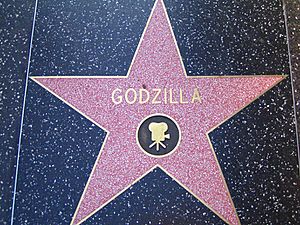
Godzilla is one of the most recognizable symbols of Japanese popular culture worldwide and remains an important facet of Japanese films.
Godzilla has been considered a filmographic metaphor for the United States, as well as an allegory of nuclear weapons in general. Godzilla represented the fears that many Japanese held about the atomic bombings of Hiroshima and Nagasaki and the possibility of recurrence.
As the series progressed, so did Godzilla, changing into a less destructive and more heroic character.
In 1996, Godzilla received the MTV Lifetime Achievement Award, as well as being given a star on the Hollywood Walk of Fame in 2004 to celebrate the premiere of the character's 50th anniversary film, Godzilla: Final Wars.
Steven Spielberg cited Godzilla as an inspiration for Jurassic Park (1993). Spielberg described Godzilla as "the most masterful of all the dinosaur movies because it made you believe it was really happening." Godzilla also influenced the Spielberg film Jaws (1975). Godzilla has also been cited as an inspiration by filmmakers Martin Scorsese and Tim Burton.
Cultural ambassador
In April 2015, the Shinjuku ward of Tokyo named Godzilla a special resident and official tourism ambassador to encourage tourism. During an unveiling of a giant Godzilla bust at Toho headquarters, Shinjuku mayor Kenichi Yoshizumi stated "Godzilla is a character that is the pride of Japan."
Movie appearances
- Godzilla (1954)
- Godzilla Raids Again (1955)
- Godzilla, King of the Monsters! (1956)
- King Kong vs. Godzilla (1962)
- Mothra vs. Godzilla (1964)
- Ghidorah, the Three-Headed Monster (1964)
- Invasion of Astro-Monster or Monster Zero (US release) (1965)
- Godzilla vs. the Sea Monster (1966)
- Son of Godzilla (1967)
- Destroy All Monsters (1968)
- All Monsters Attack (1969)
- Godzilla vs. Hedorah (1971)
- Godzilla vs. Gigan (1972)
- Godzilla vs. Megalon (1973)
- Zone Fighter (1973)
- Godzilla vs. Mechagodzilla (1974)
- Terror of Mechagodzilla (1975)
- The Return of Godzilla (1984)
- Godzilla vs. Biollante (1989)
- Godzilla vs. Mothra (1992)
- Godzilla vs. Mechagodzilla II (1993)
- Monster Planet Of Godzilla (1994)
- Godzilla vs. Space Godzilla (1994)
- Godzilla vs. Destoroyah (1995)
- Godzilla Island (1997)
- Godzilla (1998)
- Godzilla 2000: Millennium (1999)
- Godzilla vs. Megaguirus (2000)
- Godzilla, Mothra and King Ghidorah: Giant Monsters All-Out Attack (2001)
- Godzilla Against Mechagodzilla (2002)
- Godzilla: Tokyo S.O.S. (2003)
- Godzilla: Final Wars (2004)
- Godzilla (2014)
Images for kids
-
Godzilla's atomic heat beam, as shown in Godzilla (1954)
-
Godzilla battles King Kong in King Kong vs. Godzilla (1962). This film attracted the highest Japanese box office attendance figures in the entire Godzilla series to date.
-
Suit fitting on the set of Godzilla Raids Again (1955), with Haruo Nakajima portraying Godzilla on the left
-
Godzilla's star on the Hollywood Walk of Fame
See also
 In Spanish: Godzilla para niños
In Spanish: Godzilla para niños


